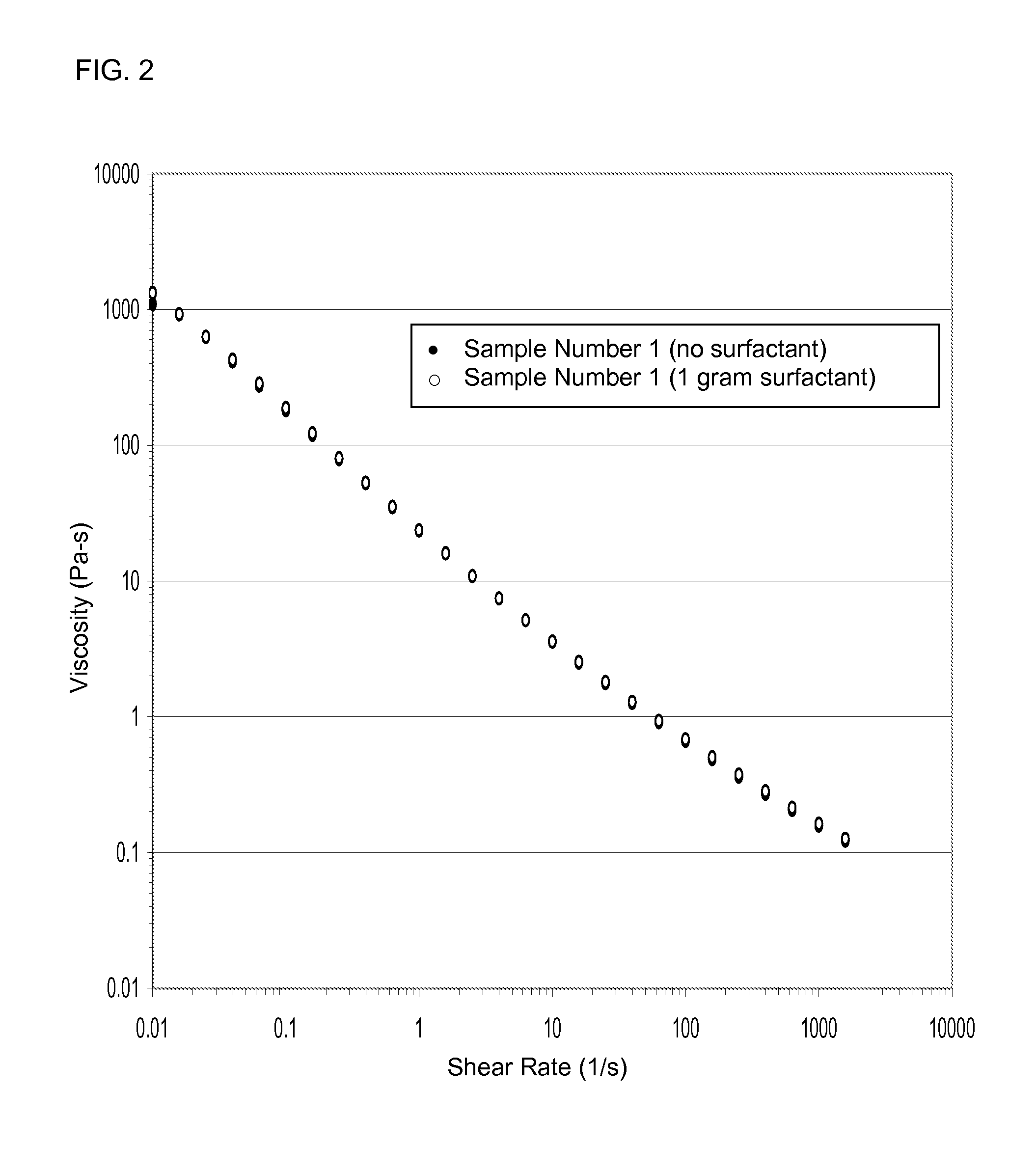Anti-settling and thickening compositions and methods for using same
a composition and thickening technology, applied in the field of polymers, can solve the problems of affecting the flow rate, affecting the leveling of paint, and many of the anti-settling agents, and achieve the effects of no or little viscosity, and imparting additional viscosity
- Summary
- Abstract
- Description
- Claims
- Application Information
AI Technical Summary
Benefits of technology
Problems solved by technology
Method used
Image
Examples
example 1
Preparation of HASE Thickener Systems
[0596]The HASE polymers are each made according to the procedure set forth below.
[0597]In one embodiment, the emulsion polymerization technique comprises charging a kettle or reactor, and then heating the kettle or reactor while purging with nitrogen. The nitrogen purge is maintained throughout the run. A monomer emulsion (ME) of DI water (deionized water), surfactant, methyl acrylic acid, ethyl acrylate, and hydrophobic associative monomer is added to the kettle, as well as an initiator solution (IS) of DI water and ammonium persulfate. The kettle is held for over approximately 3 hours at constant elevated temperature, at about 80° C., and the remainder of monomer emulsion and initiator solution is added. The kettle is held for an additional 30 minutes while rinsing the additional funnel of IS and its tubing (disconnected from the batch) with water. (The tubing is then reconnected to the batch.) Part 1 of a chaser system / solution of tertbutyl pe...
example 2
Formulation Preparation for Testing Thickening Efficiency (KU)
[0601]Formulation preparation combined 108 grams Binder (RHOPLEX SG30)+61 grams deionized water+HASE thickener of Example 1. RHOPLEX SG30 is a 100% acrylic emulsion available from Dow Coating Materials and is the binder latex.
[0602]The KU formulation described above was used to evaluate viscosity profiles and obtain the results reported on TABLES 1 and 2. The KU viscosity of the HASE thickener polymer with RHOPLEX SG30 was measured before and after addition of IGEPAL CO887 surfactant. IGEPAL CO-887 is a surfactant containing Nonylphenol ethoxylate available from Rhodia Inc.
[0603]FIGS. 1-6 show data from measuring the above-described formulation either before or after addition of surfactant.
[0604]Viscosity profiles were run as follows: At 25° C. using couette which consists of a bob and cup, one is moving relative to the other.
[0605]FIG. 1 shows Viscosity Profiles of formulations prepared with HASE thickeners containing a ...
example 3
Sample Preparation for Formulations with Stain
[0615]Table 3 shows representative examples (Sample Number 4 and Sample Number 5) having viscosity values (KU, ICI and Zhan cup) of a stain (as described below) after addition of a representative polymer as claimed herein, which incorporates the specialized hydrophobic associative monomer. A stain viscosity is also showed as reference (Sample Number 3).
[0616]
TABLE 3Experiments carried out using polymer of the present inventionincorporating the specialized hydrophobic associative monomer.ZhanSampleStainPolymerPolymerICICupTime1Number(g)ID(g)KU(P)(sec)(h)3150——48.20.1517.054150A2.051.50.1521.01685150B2.051.80.2523.01681Stability at room temperature
[0617]Sample Number 3 is a commercially available wood stain, which has a low viscosity. The stain without polymer (Sample Number 3) showed separation of pigments / fine particles from solution within 5 hours. The stains with polymer synthesized with the specialized associative monomer (Sample Numb...
PUM
| Property | Measurement | Unit |
|---|---|---|
| weight percent | aaaaa | aaaaa |
| weight percent | aaaaa | aaaaa |
| weight percent | aaaaa | aaaaa |
Abstract
Description
Claims
Application Information
 Login to View More
Login to View More - R&D
- Intellectual Property
- Life Sciences
- Materials
- Tech Scout
- Unparalleled Data Quality
- Higher Quality Content
- 60% Fewer Hallucinations
Browse by: Latest US Patents, China's latest patents, Technical Efficacy Thesaurus, Application Domain, Technology Topic, Popular Technical Reports.
© 2025 PatSnap. All rights reserved.Legal|Privacy policy|Modern Slavery Act Transparency Statement|Sitemap|About US| Contact US: help@patsnap.com



